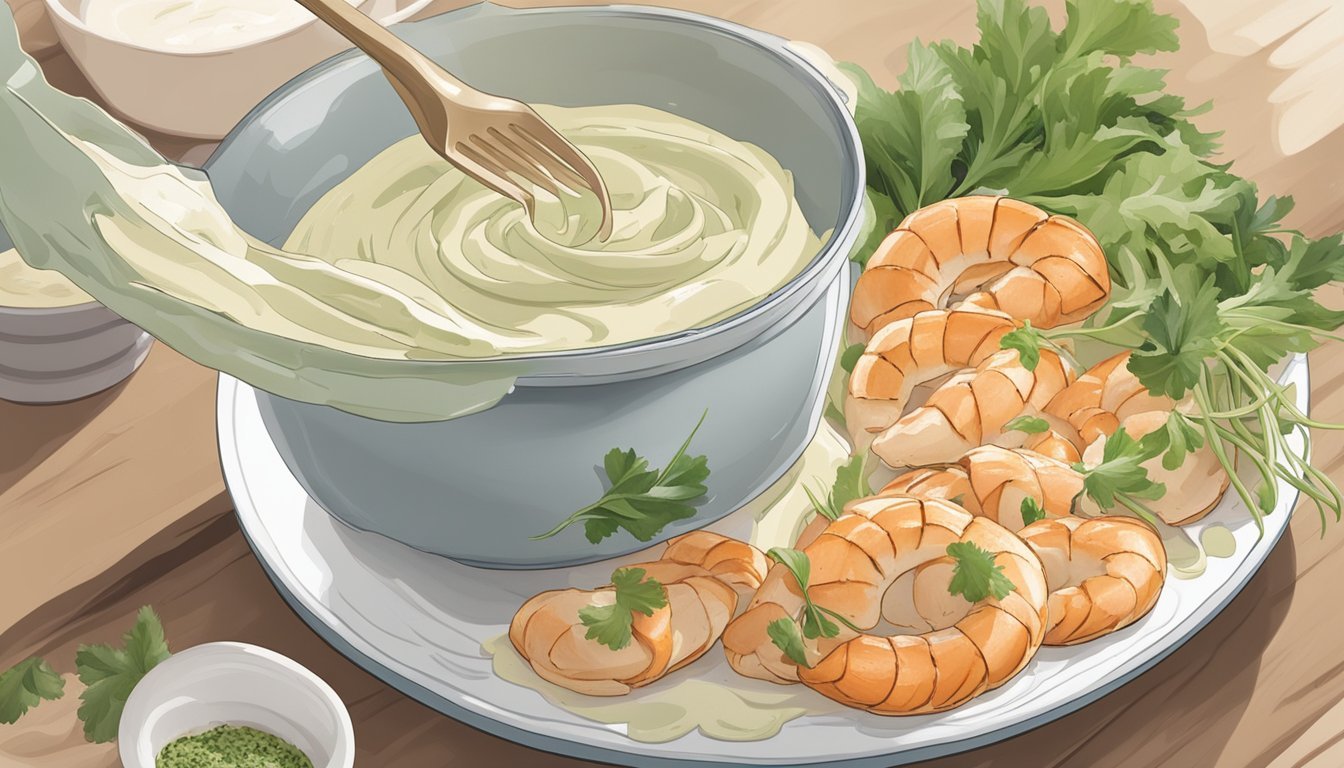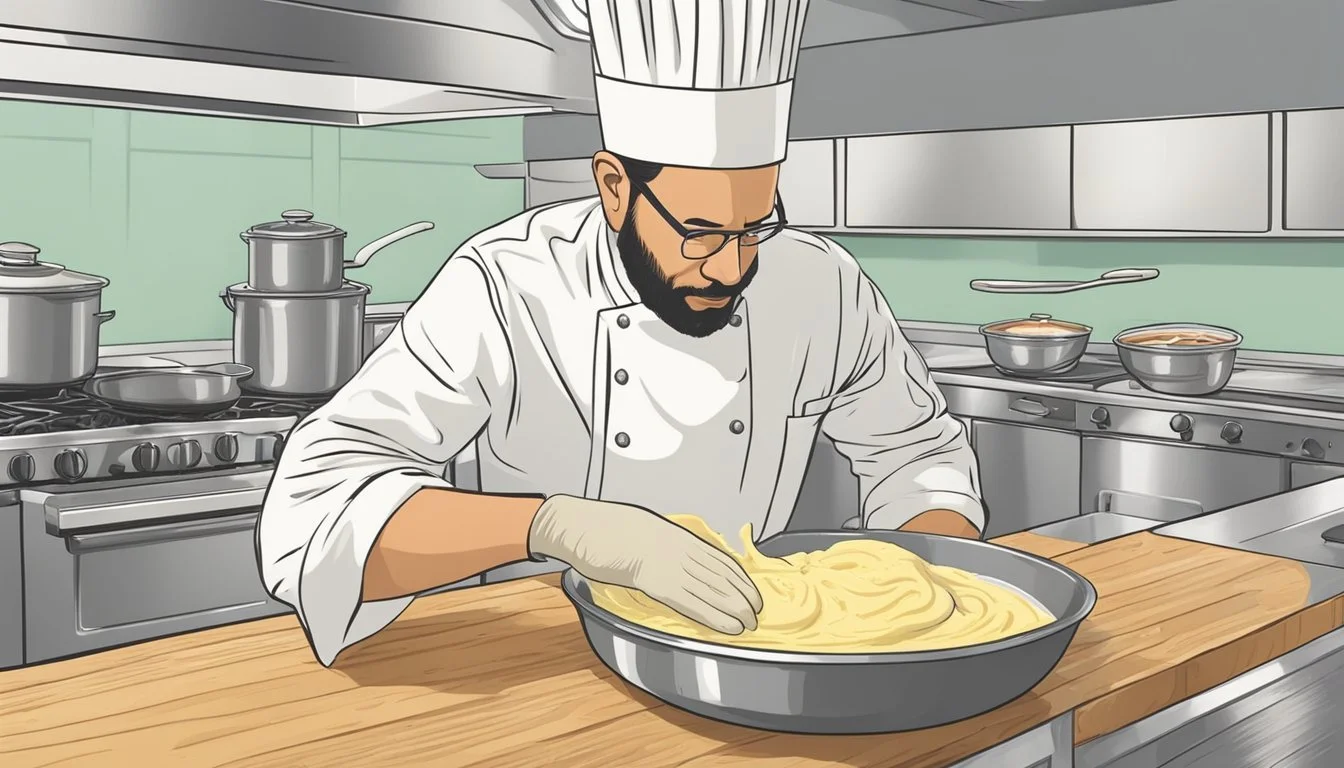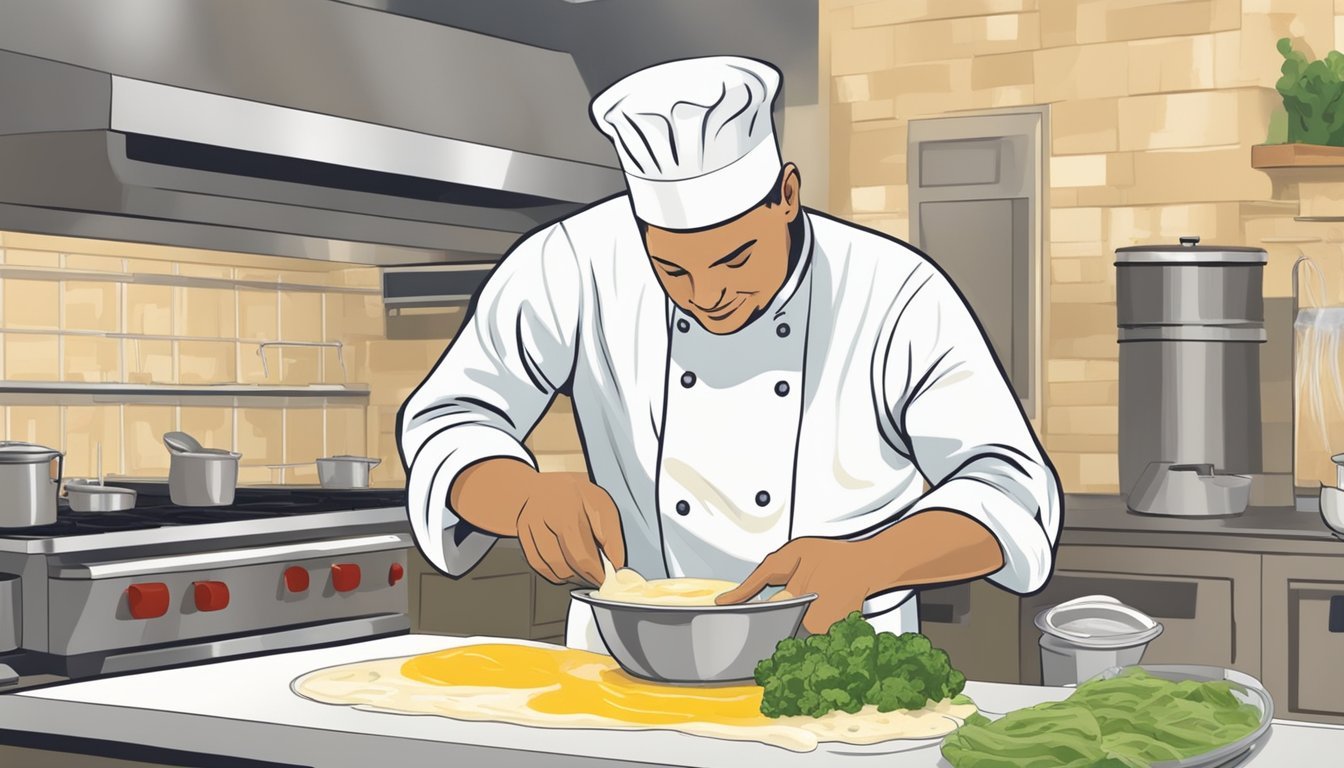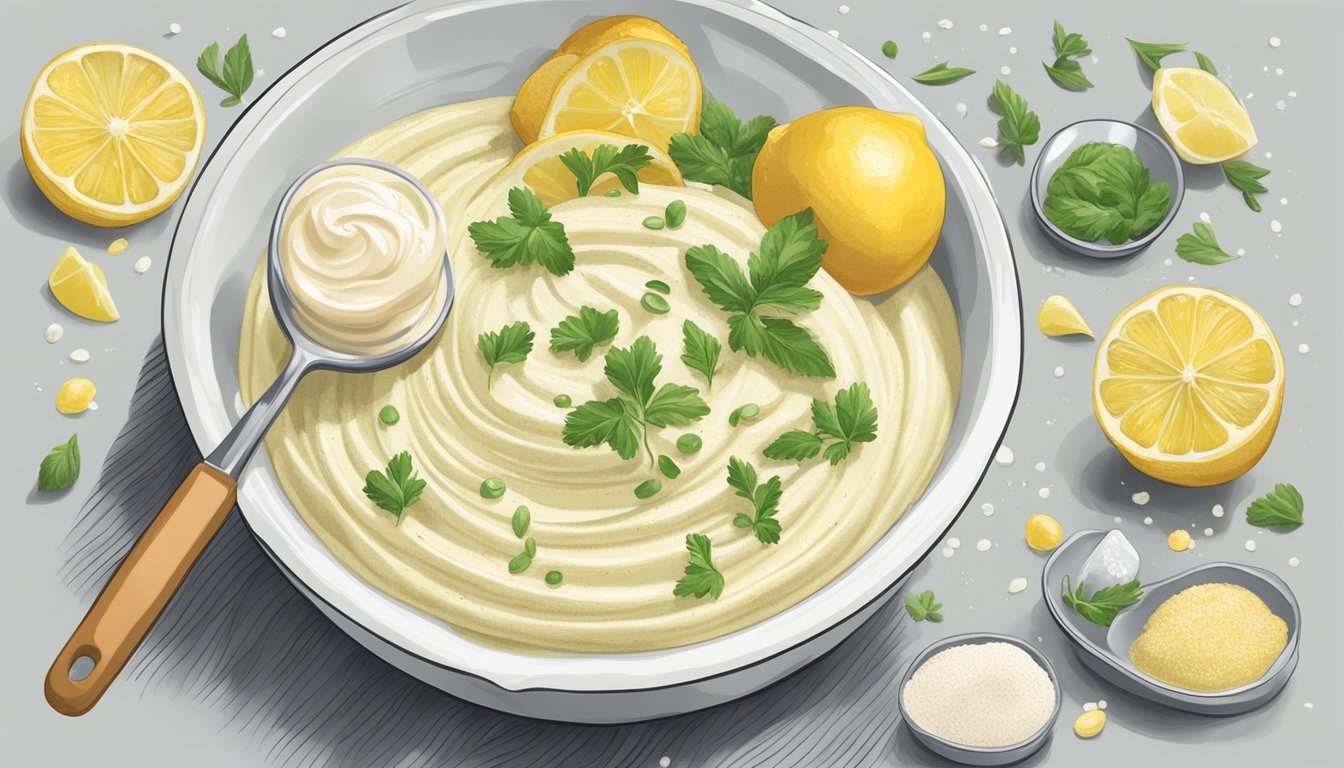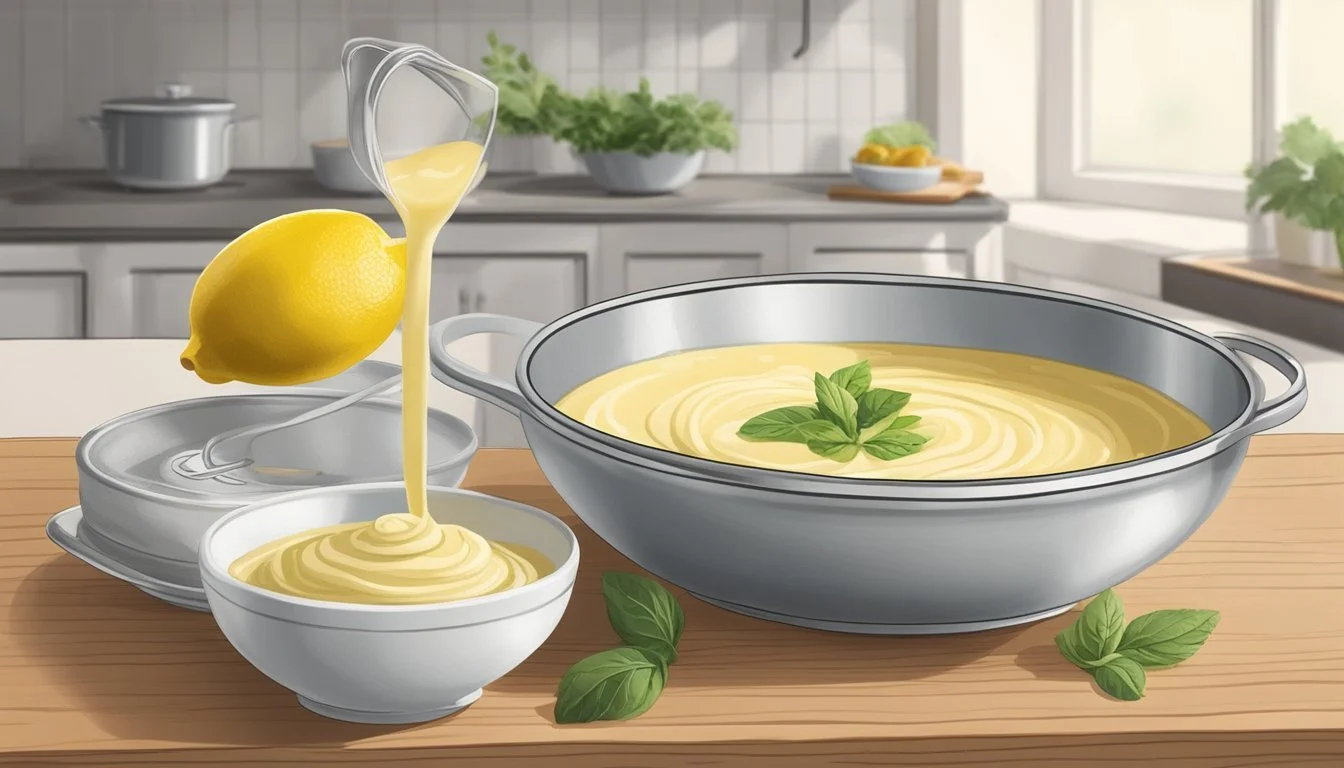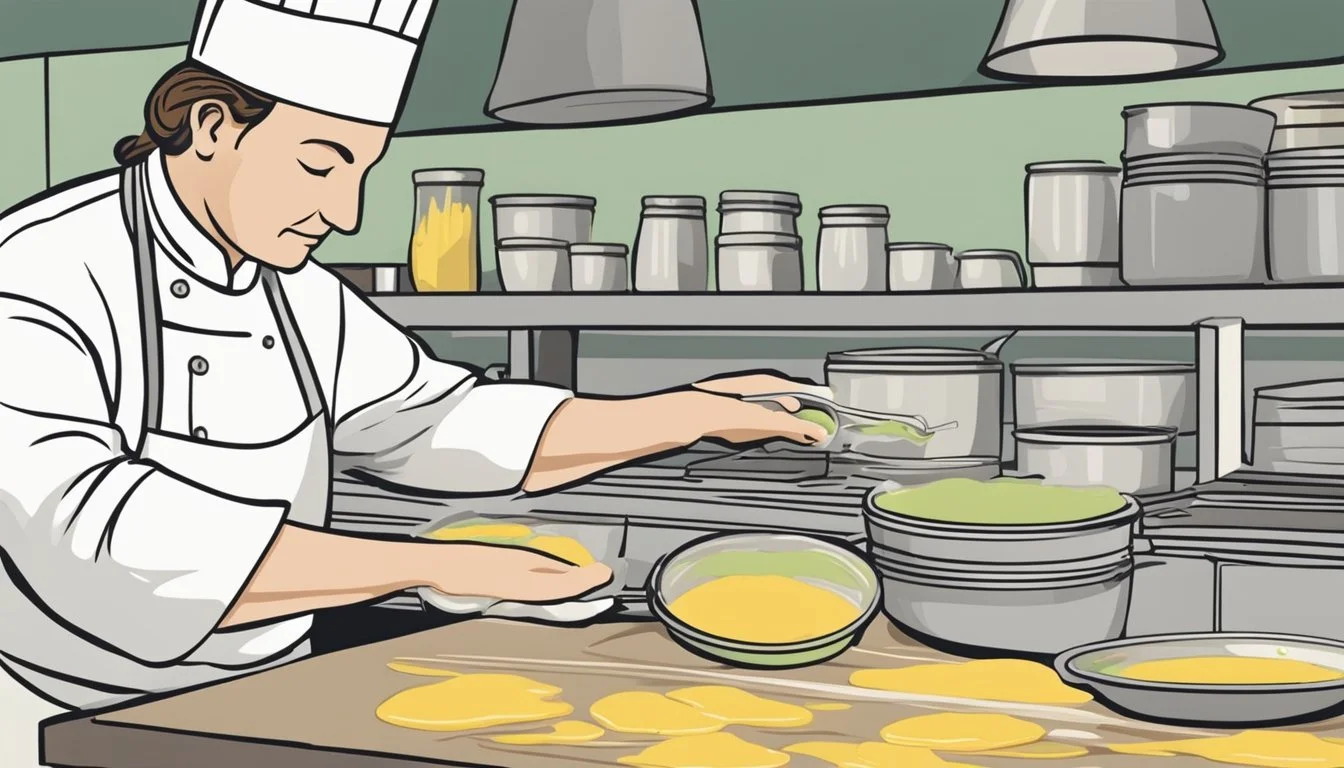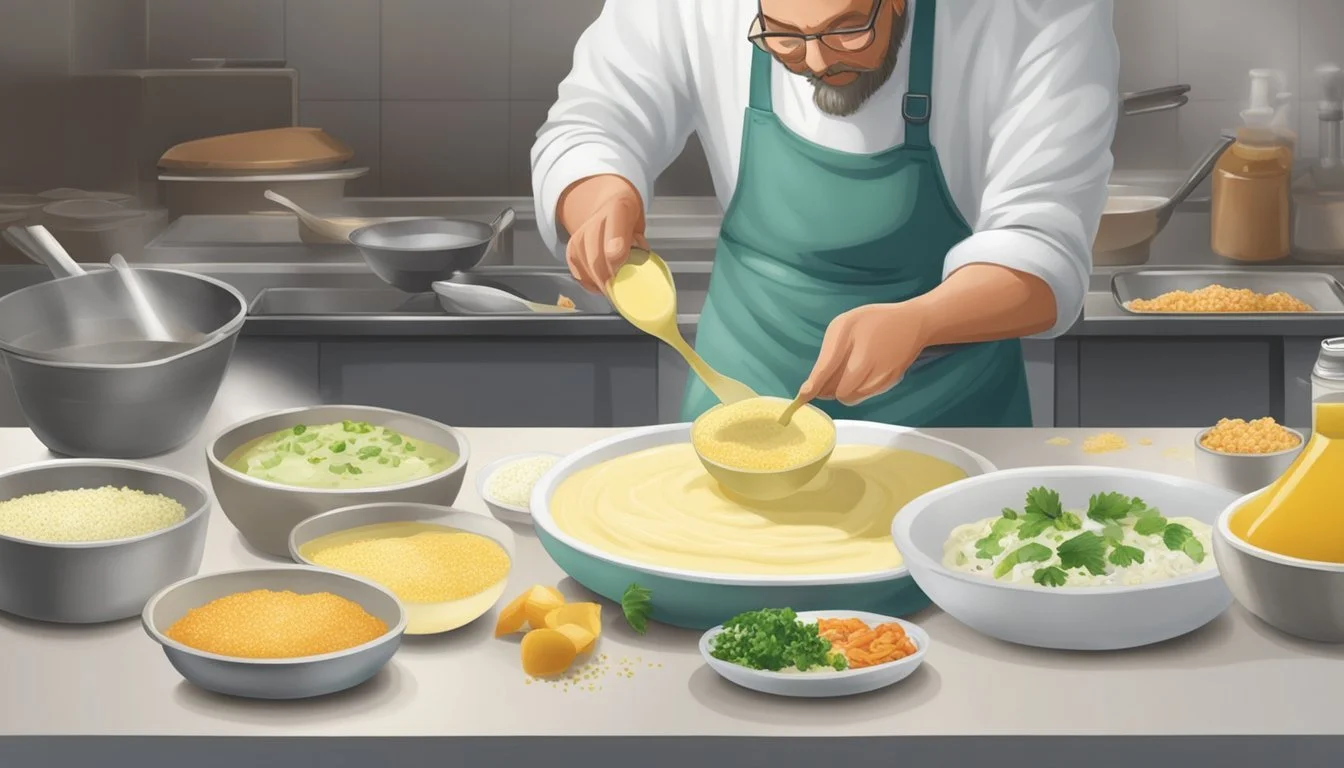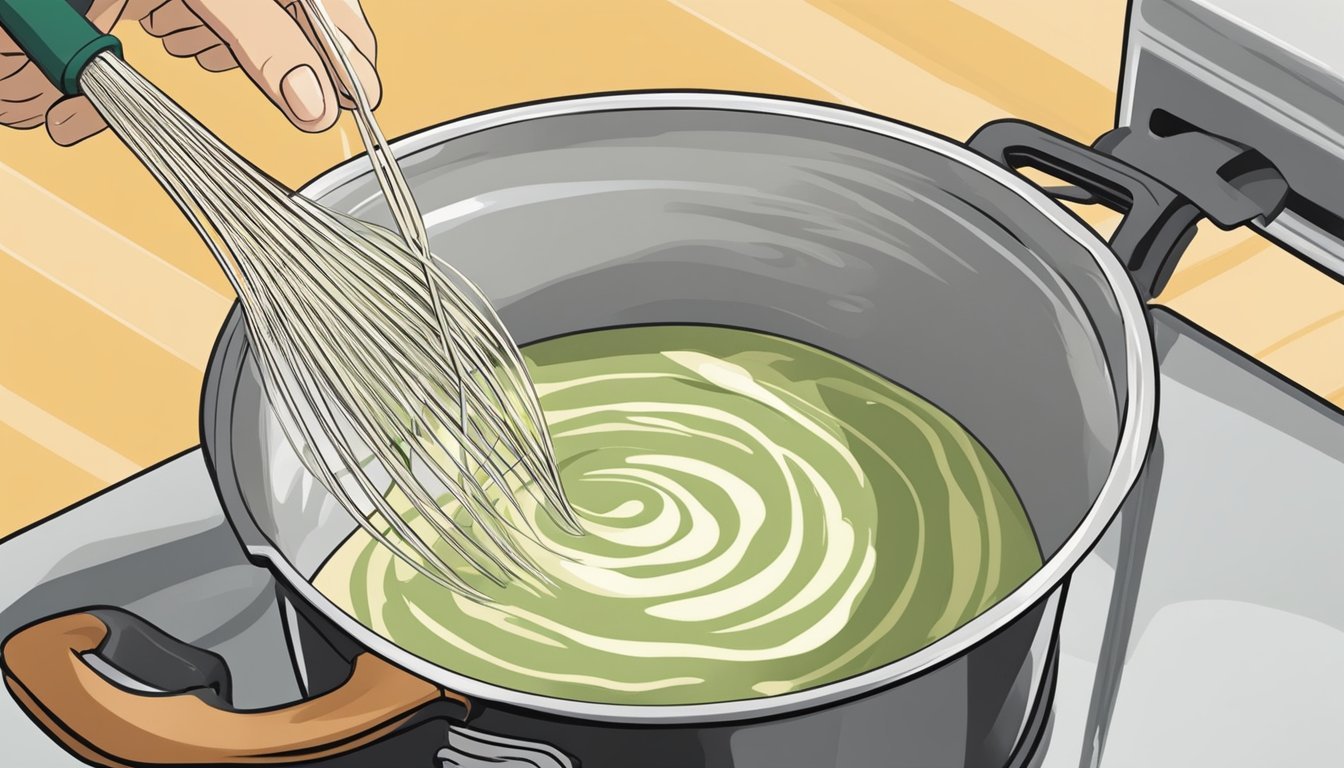Fixing Watery Remoulade Sauce
Expert Tips for Achieving the Perfect Consistency
Remoulade sauce is a flavorful condiment often served with seafood (What wine goes well with seafood?), but it can become watery, affecting both its texture and its ability to cling to foods. A thick and creamy remoulade not only enhances the appearance of dishes like crab cakes (What wine goes well with crab cakes?) and shrimp (What wine goes well with shrimp?) but also ensures that each bite is enriched with its tangy and spiced flavor profile. Addressing the consistency of this sauce is essential to maintain the delicate balance of flavors it's known for, which includes notes of mustard, capers, (What wine goes well with capers?) and herbs in traditional versions, or the heat of Cajun spices in regional variations.
Thickening watery remoulade involves careful consideration of the ingredients and thickening agents that complement the existing flavors in the sauce. Techniques to reach the desired thickness include the addition of emulsifying agents such as mayonnaise, which can bring together oil and vinegar-based components to create a cohesive mixture. In addition, culinary methods, such as reduction through simmering, can evaporate excess moisture and concentrate the sauce's flavors.
Understanding Remoulade Sauce
The reader will gain an understanding of remoulade’s diverse origins and the essential components that make up this versatile sauce.
Origins and Variations
Remoulade sauce has a rich history that originates from France, where it first appeared as a white, mayonnaise-based condiment. French-style remoulade typically features a blend of mayonnaise, Dijon mustard, capers, pickles, herbs like tarragon, and sometimes vinegar or horseradish. The sauce is known for its creamy texture and savory taste.
In contrast, Louisiana remoulade sauce, with its roots in Cajun and Creole cuisine, presents a variation that is often seasoned with Cajun seasoning or Creole seasoning. This version is usually reddish or orange in color, signifying the addition of ingredients like Creole mustard, hot sauce, and/or ketchup, which results in a more piquant and robust flavor profile.
Key Ingredients
The key ingredients define remoulade sauce and their purpose are outlined below:
Mayonnaise: Serves as the base for both French and Louisiana-style remoulade, providing a creamy texture.
Mustard: Dijon for the French style, Creole for the Louisiana style, it adds a tangy, sharp taste.
Capers and Pickles: Commonly found in French-style sauce, they offer a briny, salty flavor.
Herbs: Such as tarragon, basil, or parsley, contribute freshness and depth.
Acidic Components: Such as vinegar or lemon juice, balance the richness with brightness.
Seasonings: Cajun seasoning often includes paprika, garlic powder, and cayenne, while Creole seasoning can be a blend of similar spices with variations based on the chef’s recipe, both introducing a characteristic warmth and complexity to Louisiana remoulade.
Common Issues with Remoulade Sauce
Remoulade sauce is a flavorful accompaniment to seafood that should have a thick and creamy texture. However, it sometimes turns out thinner than desired.
Analyzing Watery Consistency
When the texture of remoulade sauce is more liquid than creamy, it undermines the sauce's ability to cling to foods such as shrimp or crab cakes. Several factors can cause this:
Ingredient Ratios: Incorrect proportions of liquid ingredients to thickeners can result in a sauce lacking sufficient body.
Mixing Method: Inadequate emulsification can lead to separation, where oil and watery components do not blend properly.
Temperature Control: Exposure to high heat can break down emulsions and cause sauces to separate and become watery.
Consistency issues in remoulade sauce not only affect its mouthfeel but also its appearance and ability to enhance the main dish. A proper balance of ingredients and technique is essential to achieve the desired texture.
Preparation Techniques
Achieving the ideal thickness in homemade remoulade sauce hinges on two pivotal aspects: Proper Mixing Methods and Ingredient Ratios. Attentiveness to these elements ensures a sauce with the desired consistency for an appetizing accompaniment to seafood dishes. (What wine goes well with seafood dishes?)
Proper Mixing Methods
When preparing homemade remoulade sauce, it's essential to mix the ingredients in a manner that promotes emulsification—the process in which mayo, the sauce's base, combines thoroughly with the other components to create a uniform and stable texture. One should start by combining the mayo with potent flavor agents like Dijon mustard or minced garlic, ensuring these elements are blended evenly before adding any thinner liquids, such as vinegar or lemon juice.
To properly incorporate each ingredient:
Start with mayo: Place the mayonnaise in a bowl as the foundation for building flavor.
Add thick flavorings: Incorporate ingredients like mustard or seasonings, whisking until smooth.
Whisk in liquids: Gradually mix in any vinegars or juices to ensure a well-emulsified sauce.
Ingredient Ratios
The key to a thick remoulade sauce lies not only in the mixing technique but also in the precise balance of ingredients. Mayo, being the primary thickening agent, should be present in sufficient quantity to maintain a creamy texture. A common mistake is diluting the mayo with an excess of liquid, such as vinegar or lemon juice, which can lead to a watery consistency.
For an ideal balance, consider the following ratios:
Mayo Base: 3/4 cup
Mustard (Dijon or Creole): 2 tablespoons
Vinegar (White Wine or Lemon Juice): 1 teaspoon to 1 tablespoon depending on desired tanginess
Seasonings (Cajun, Tarragon, etc.): Adjust to taste; remember, dried herbs can help absorb excess moisture
By closely monitoring these ratios and adjusting as necessary, one can achieve a remoulade sauce with a rich consistency perfect for pairing with crab cakes, salmon, or a classic seafood boil.
Thickening Agents
To fix a watery remoulade sauce and attain the desired consistency, one can use various thickening agents such as starches and dairy products. The proper application of these substances will enhance the sauce's texture without altering its flavor profile.
Using Starches
Starches are a popular choice for thickening remoulade sauces due to their neutral flavor and effective binding properties. The key is to create a slurry by mixing the starch with an equal part of cold water before introducing it to the sauce.
Cornstarch: Mix 1 tablespoon of cornstarch with 2 tablespoons of water to form a slurry. Gradually whisk it into the remoulade sauce.
Flour: Flour can be cooked with butter to create a roux, which is then slowly whisked into the sauce.
Arrowroot: Similar to cornstarch but with a glossier finish, it is mixed with water to make a slurry.
For each starch, ensure it's completely dissolved in water to prevent clumps. Start with a smaller amount; one can always add more if necessary.
Incorporating Dairy Products
Dairy products add richness while also having thickening capabilities. Care must be taken to incorporate them correctly to avoid separation or curdling.
Cream: Adding heavy cream can thicken a remoulade sauce and contribute a luxurious mouthfeel.
Butter: Stirring in cold, diced butter at the end of cooking can thicken and emulsify the sauce.
When using dairy, warm it up slightly before mixing it into the sauce to prevent shocking the mixture, which can cause curdling.
Culinary Techniques
In addressing watery remoulade sauce, chefs often turn to heat application and reduction methods. These techniques not only improve consistency but also enhance flavor concentration, ensuring a complement to a variety of seafood dishes.
Application of Heat
When a remoulade sauce is too thin, applying gentle heat can assist in thickening. Simmering the sauce over a low flame encourages gradual evaporation without affecting the delicate balance of flavors. It is critical to stir continuously, preventing the ingredients from settling and sticking to the bottom of the pan.
Reduction Methods
The principle of reduction is a time-honored technique to intensify flavor and achieve the desired sauce thickness. Reduction involves:
Simmering: Allow the sauce to cook uncovered over low heat.
Monitoring: Keep an eye on the sauce's consistency, ensuring it doesn't reduce too much.
Stirring: Frequent stirring ensures even thickening.
Through reduction, water in the sauce evaporates, leading to a richer and more robust flavor profile, as well as a thicker consistency.
Flavor Enhancement
Enhancing the flavor of remoulade sauce ensures that it complements seafood dishes perfectly. This section will guide you through balancing the interplay of tangy and sweet flavors and the judicious use of herbs and seasonings to elevate your sauce.
Balancing Tanginess and Sweetness
A harmonious remoulade sauce has a balance of tanginess and sweetness. Lemon juice provides a bright, tangy flavor that can be adjusted according to taste. For sweetness, one may consider finely chopped green onion or a pinch of sugar. Adjust these elements to find the right contrast that complements the underlying flavors of the seafood.
Tanginess: Primary source - Lemon juice
Sweetness: Suggested additions - Green onion, sugar
Herbs and Seasonings
The right combination of herbs and spices can transform a sauce from ordinary to extraordinary. Dill and tarragon are traditional herbs that offer a refreshing and slightly anise-like quality. For enhancing the heat and depth of the sauce, one can incorporate spices such as Cajun seasoning, paprika, smoked paprika, Old Bay, or cayenne pepper. Not to be overlooked, mustard—preferably Dijon—provides a robust base, while garlic and horseradish contribute a pungent, earthy kick to the remoulade's profile.
Herbs:
Dill
Tarragon
Seasonings for heat:
Cajun seasoning
Paprika
Smoked paprika
Old Bay
Cayenne pepper
Bold flavors:
Mustard (especially Dijon)
Garlic
Horseradish
By paying close attention to these aspects of flavor enhancement, your remoulade sauce will not only have the ideal consistency but also a full, well-rounded taste that stands up alongside any seafood dish.
Complementary Pairings
Selecting the right food to accompany your remoulade sauce is essential for creating a harmonious meal. This section covers ideal pairings of seafood and meats as well as vegetables and starches that will enhance the flavors of each dish.
Seafood and Meat
The creamy and tangy nature of remoulade sauce makes it an exceptional complement to a variety of seafood and meat dishes. Here are specific pairings:
Seafood:
Shrimp: The sauce adds zest to both grilled and fried shrimp.
Crab Cakes: A dollop of remoulade sauce creates a delightful balance of flavors.
Fish: Whether salmon or white fish (What wine goes well with white fish?), remoulade serves as a rich topping.
Oysters (What wine goes well with oysters?): The sauce's acidity complements the briny taste of oysters.
Meat:
Chicken: Ideal as a topping for grilled or fried chicken.
Burgers: A spread of remoulade on burgers can replace traditional condiments.
Vegetables and Starches
Paired with remoulade sauce, vegetables and starches can be elevated from simple sides to standout dishes.
Vegetables:
Fried Green Tomatoes: The remoulade enhances their crispy texture.
Cauliflower: Either roasted or fried, cauliflower pairs well with the tangy sauce.
Beans: Adds a creamy texture to bean salad.
Starches:
Potatoes: A side of remoulade is a rich accompaniment to boiled or roasted potatoes.
Fries: Be it standard french fries or sweet potato fries, remoulade can be used as a unique dipping sauce.
Veggies: A mix of fried veggies, like zucchini or mushrooms, can be dipped into remoulade for extra flavor.
Serving and Storage
Proper serving and storage are critical for maintaining the flavor and texture of remoulade sauce. This section provides guidance on the optimal temperature for serving and the best practices for preserving the sauce long-term.
Optimal Serving Temperature
Remoulade sauce should be served chilled to complement the temperature of cold seafood dishes. Serving it directly from the refrigerator, typically at a temperature range of 35-40°F (1.7-4.4°C), ensures that the sauce retains its thickness and flavor. It is recommended to let the sauce sit at room temperature for no more than 5 minutes before serving; this brief period allows it to slightly temper, enhancing its taste without compromising its consistency.
Long-Term Preservation
To preserve remoulade sauce for extended periods, one should store it in an airtight container. This reduces exposure to air, preventing the growth of bacteria and preserving the sauce's quality. The refrigerator is adequate for keeping the sauce fresh for up to one week.
For longer storage, freezing is an option, although it may alter the texture due to the emulsification process. If freezing, be aware that a quick thaw in the refrigerator is preferable to maintain its integrity. Partially thawed sauce can be stirred to re-emulsify ingredients before serving.
Here's a brief format for best storage practices:
Refrigeration: Up to 1 week in an airtight container
Freezing: Possible, but may affect texture; thaw in refrigerator
Remember, always ensure that the lid of the container is securely fastened to maintain freshness and prevent any unpleasant odors from affecting the taste of your sauce.
Special Dietary Adaptations
When it comes to adapting remoulade sauce for special diets, one must consider both caloric and allergenic restrictions. The following subsections explore ways to reduce calories and fat without sacrificing flavor, and how to modify recipes for gluten-free and vegan diets while maintaining the classic characteristics of this beloved condiment.
Reducing Calories and Fat
For individuals monitoring their calorie and fat intake, traditional remoulade can be modified. The usual base of full-fat mayonnaise can be substituted with low-fat or non-fat versions, or with Greek yogurt, which offers a tangy flavor along with a thicker consistency. Greek yogurt not only decreases the caloric content but also provides additional protein.
Substitute Options:
Full-fat mayonnaise → Low-fat/no-fat mayonnaise
Full-fat mayonnaise → Greek yogurt
One may also consider reducing the quantity of oil in the recipe, if any is used, to further cut down on calories and fat.
Gluten-Free and Vegan Options
For those on a gluten-free or vegan diet, preparing an accommodating remoulade sauce requires specific alternations. Gluten-containing ingredients should be avoided entirely. For a gluten-free adaptation of remoulade sauce, ensure that any prepared mustards or seasoning blends used are certified gluten-free.
To make a vegan remoulade, one can utilize vegan mayonnaise made from plant-based ingredients as the base. It's crucial to check the labels of all other ingredients like mustards and capers to confirm they don't contain any animal-derived additives.
Substitute Options:
Traditional mayonnaise → Vegan mayonnaise
Ensure all other ingredients (mustard, capers, etc.) are vegan-certified
In both cases, care should be taken to follow the recipe closely and adjust seasonings as necessary to ensure the final product retains the desired flavor profile.
Tools and Utensils
In fixing watery remoulade sauce, it is important to have the right tools to achieve the desired thickness without compromising the sauce's flavor or texture.
Necessary Kitchen Equipment
Whisk: Essential for stirring and integrating thickening ingredients smoothly into the remoulade sauce.
Spoons or Spatulas: Useful for stirring and ensuring the sauce thickens evenly.
Food Processor: A food processor can be utilized to blend some of the solid ingredients before adding them to the sauce for a thicker consistency.
Final Touches
After thickening the remoulade sauce to the desired consistency, final touches can elevate both its flavor and presentation. A carefully selected garnish can add a pop of color, while serving techniques can enhance the overall dining experience.
Garnishing Tips
Adding garnishes to remoulade sauce not only enhances the flavor but also adds a visual appeal that can make seafood dishes more appetizing. Consider the following:
Capers: A sprinkle of capers lends a briny, salty burst that complements the creamy remoulade.
Parsley: Finely chopped fresh parsley offers a fresh, herbaceous note and vibrant green color.
Lemon: A few twists of lemon zest or a light drizzle of fresh lemon juice can brighten the sauce with acidity.
Green Onion: Sliced green onion provides a sharp, oniony bite and an appealing visual contrast.
Creative Serving Suggestions
How the remoulade sauce is served can greatly impact the enjoyment of the dish. Here are a few suggestions to consider:
With Pickles: Dill pickles or cornichons can be served alongside the sauce, giving diners the option to combine piquant pickled flavors with the rich sauce.
Lemon Wedge Accompaniment: A simple lemon wedge on the plate allows guests to add a squeeze of fresh juice to their taste.
Herb-Infused Drizzles: Create an herb oil with parsley or dill and drizzle it over the sauce for an extra layer of flavor and a professional touch.
Troubleshooting and Adjustments
In perfecting the remoulade sauce, adjustments in consistency and flavor are paramount. It ensures the resultant condiment complements various seafood dishes impeccably. This section will navigate through rectifying an over-thickened sauce and fine-tuning the seasoning to achieve that ideal balance.
Fixing Over-Thickened Sauce
Should a remoulade become excessively dense, one can carefully dilute it using a small addition of liquid. Preferable liquid choices include:
Lemon juice for a tang
Water for a neutral effect
Additional vinegar for tartness
Incorporate slowly, mixing thoroughly after each addition until the desired consistency is reached.
Seasoning Corrections
For too bland a remoulade, it may require a boost in flavor profile. The addition of fine-grained salt, a pinch at a time, or a few drops of Tabasco can enhance the overall taste significantly. In contrast, a sauce too pungent might benefit from a minute quantity of sugar to provide balance. It is essential to add these ingredients gradually, ensuring they fully integrate by tasting after each adjustment. The goal is to achieve a harmonious blend of the remoulade's simple ingredients.
Frequently Asked Questions
When seeking to perfect one's culinary skills, troubleshooting is part of the process. This section addresses common concerns about achieving the desired consistency in remoulade sauce, a versatile condiment often served with seafood.
Common Queries About Remoulade Sauce
What makes remoulade sauce different from tartar sauce?
Remoulade is a condiment similar to tartar sauce but tends to have a more complex flavor profile, often including ingredients like mustard, garlic, paprika, and sometimes horseradish. Tartar sauce usually has a simpler taste focusing on pickles and mayonnaise.
How can one fix a watery remoulade sauce?
To fix a watery remoulade sauce, you can:
Whisk in an egg yolk: Slowly whisk an egg yolk into the sauce to add richness and thickness.
Introduce starch: A slurry made from cornstarch or potato starch mixed with water can effectively thicken the sauce.
Can remoulade sauce be used as a topping or a dipping sauce?
Absolutely. Remoulade sauce is a versatile condiment that can be used both as a topping over dishes like po' boys and as a dipping sauce for fried foods, such as shrimp or fish.
In what dishes is remoulade sauce traditionally used?
Remoulade sauce is traditionally served with seafood, particularly in Southern cuisine, and is a classic topping for the New Orleans favorite, shrimp remoulade salad. It's also commonly paired with fried foods as a flavorful complement.
How long can you store homemade remoulade sauce? A homemade remoulade sauce should be stored in a refrigerator and typically remains fresh for up to one week when properly stored in a sealed container.

